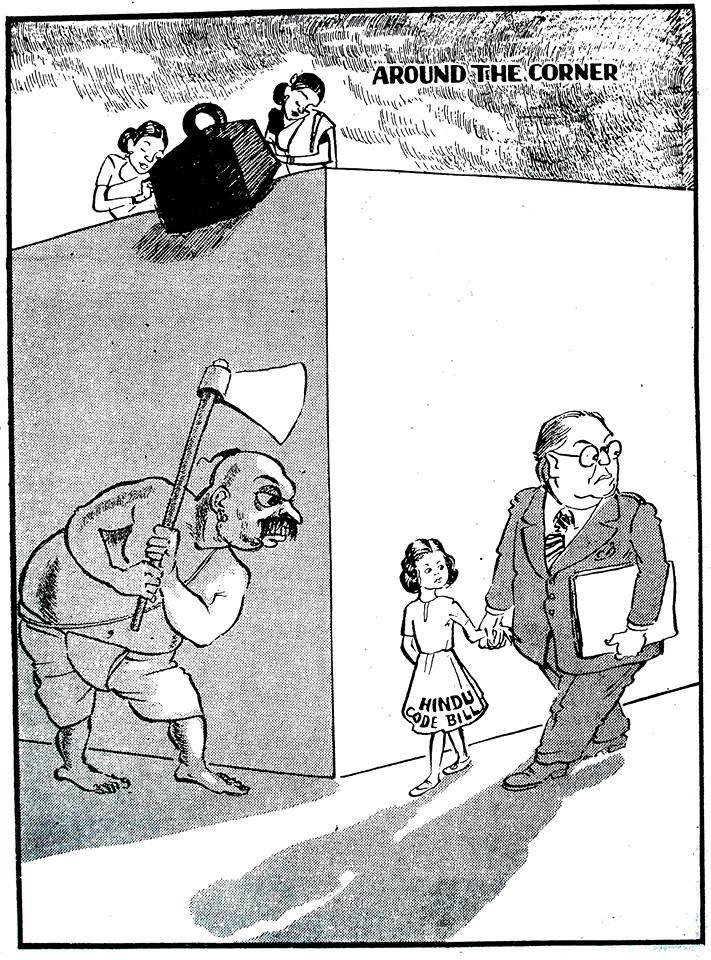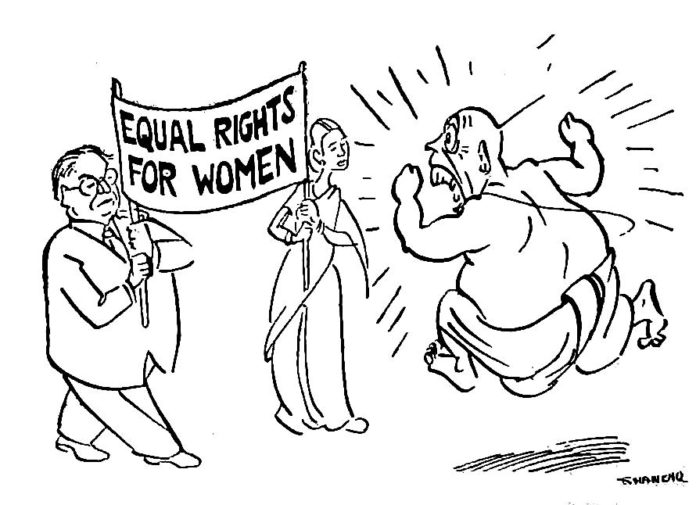Babasaheb Ambedkar is one of the first feminist leaders and women’s rights advocates in the country. “I measure the progress of a community by the degree of progress which women have achieved” Babasaheb had said. Despite this, his feminist contributions are often ignored and denied.
Even Indian Feminists often limit his work to the betterment of Dalit women’s lives. This invisibalization of Ambedkar and his life’s work is symptomatic of upper caste feminist movements. Ambedkar is only called upon when upper-caste women speak to and of Dalit women, beyond that Babasaheb’s work in pushed to the margins.
Ambedkar´s contribution is not an outlier to feminist struggles but has been instrumental in shaping women’s rights in the country.
 In his essay Castes in India Babasaheb outlines how endogamy was the essence of the caste system. He details how the focus on maintaining caste exclusivity leads to the rise of Sati and child marriage. He articulates through this piece the linkages between caste and the subordination of women. Ambedkar has always maintained that women were the gateways of the caste system and the caste system lay down a structure for the subordination of women and it had to be uprooted. He saw castes’ exclusionary violence and subjugation of women inherent to the very process that lead to caste formation.
In his essay Castes in India Babasaheb outlines how endogamy was the essence of the caste system. He details how the focus on maintaining caste exclusivity leads to the rise of Sati and child marriage. He articulates through this piece the linkages between caste and the subordination of women. Ambedkar has always maintained that women were the gateways of the caste system and the caste system lay down a structure for the subordination of women and it had to be uprooted. He saw castes’ exclusionary violence and subjugation of women inherent to the very process that lead to caste formation.
Ambedkar in his other works details the gendered violence that women face withing Hindu Smritis and Vedic texts. In the Manusmriti for example, Manu set the ideal for women to worship her husband despite all his flaws. He says “Manu can hardly be said to be more tender to women than he was to the Shudra.”
“I measure the progress of a community by the degree of progress which women have achieved”-B R Ambedkar
Ambedkar did not only right for women’s rights, he continuously worked with women to realize the ambition of equality amongst genders. He advocated for the rights of sex workers and spoke out against the casteist nature that was the foundation of sex-work. He worked to ensure that women were also protected under labour laws. He was instrumental in reducing the number of working hours and improving the working conditions. In 1928, as a member of the Legislative Council of Bombay, he supported a Bill granting paid maternity leave for women working in factories. He was of the view that if the employer was getting benefits off of women’s labour, they should also be supporting women, partly, when they are on their maternity leave. The other half he believed should be paid by the government as it was in the interest of the nation. Ambedkar also believed that women have the right over their own body. He said that conception was a choice that women should make. He argued for reproductive rights for women, recommended that birth control facilities be made available to them, and was a strong advocate of women’s reproductive freedom.
Ambedkar Jayanti, Anand Teltumbde arrest and the casteist face of power
He also drafted the Mines Maternity Benefit Act which asked for equal wages and equal representation of women on the welfare fund for the coal mine workers, and emphasised equal citizenship and women’s right to economic development as crucial for women’s rights in India. Between 1942 and 1946 he passed several progressive legislations for women that dealt with equal wages for equal work, casual and privilege leave, compensation in cases of injury, and pension.
Hindu Code Bill: Ambedkar´s antidote to Brahminical Patriarchy
 One of the biggest testaments to Ambedkar’s feminism was the Hindu Code Bill. Ambedkar was entrusted with drafting the Hindu Code Bill. This Bill was to codify property practices for men and women, design law of maintanence, marriage, divorce, adoption amongst other issues. Ambedkar used this as an opportunity to ensure women had full access to rights within the system. He included the issue of abolition of birth-right to property, property by survivorship, half share for daughters, conversion of women’s limited estate into an absolute estate, abolition of caste in matters of marriage and adoption, and the principle of monogamy and divorce. Ambedkar stood by these issues in face of strong opposition from conservative Hindu men in the parliament.
One of the biggest testaments to Ambedkar’s feminism was the Hindu Code Bill. Ambedkar was entrusted with drafting the Hindu Code Bill. This Bill was to codify property practices for men and women, design law of maintanence, marriage, divorce, adoption amongst other issues. Ambedkar used this as an opportunity to ensure women had full access to rights within the system. He included the issue of abolition of birth-right to property, property by survivorship, half share for daughters, conversion of women’s limited estate into an absolute estate, abolition of caste in matters of marriage and adoption, and the principle of monogamy and divorce. Ambedkar stood by these issues in face of strong opposition from conservative Hindu men in the parliament.

The focus of the bill was to give women absolute right over property, absence of endogamy, the access to divorce, and to relieve women of the threat of polygamy.
The aim was to oppose the practices of Brahminical patriarchy and thus stop its reproduction.
The Bill kept getting tabled in the parliament with promises to address it “at a later point in time” but this never happened. The house was well aware of the power of disruption that the bill possessed. It could shake the foundations of patriarchal control over production and reproduction.
In despair, Ambedkar resigned. In his resignation speech Ambedkar said:
“The Hindu Code was the greatest social reform measure ever undertaken by the legislature in this country. No law passed by the Indian legislature in the past or likely to be passed in the future can be compared to it in point of its significance. To leave inequality between class and class, between sex and sex, which is the soul of Hindu society, untouched and to go on passing legislation relating to economic problems is to make a farce of our Constitution and to build a palace on a dung heap. This is the significance I attached to the Hindu Code. It is for its sake that I stayed on, notwithstanding my differences.”
Movements headed by Ambedkar always had women walking side-by-side with the men. During the Mahad Satyagraha 10,000 men and women walked together to break the law on not allowing the Mahars to drink water. This was in contrast to Gandhi’s Salt Satyagrah, during which there were no women who were allowed to participate. In the Kalaram temple-entry movement Ambedkar inspired women to come out of their social arenas and speak with courage. In 1930, 15000 people came out to be part of this movement. Radhabai Vadale, who was one of the women who was moved by Babasaheb’s call, said, “”It is better to die a hundred times than to live a life of humiliation.” This was a testament to the fact that Ambedkar had inspired confidence in women to fight for their rights.
In an address to the All-India Depressed Classes Women’s Conference he told women:
“Give education to your children. Instill ambition in them… Don’t be in a hurry to marry; marriage is a liability. You should not impose it upon children unless financially they are able to meet the liabilities arising from them. Above all let each girl who marries stand up to her husband, claim to be her husband’s friend ad equal, and refuse to be his slave. “
This was telling of Ambedkar’s feminism and his push to ensure women were not enslaved to the patriarchal ideas as mapped in the Hindu religion. Ambedkar rallied for the rights to equal partnership in marriage well before Savarna feminists, who appropriated his call.
Dr. Ambedkar started a newspaper called ‘Mooknayak’ in January 1920. He started a biweekly called ‘Bahishkrut Bharat’ in 1927, and both these newspapers regularly covered issues related to women and their rights. In a time where women were constantly pushed to the margins, Ambedkar worked to fight against this marginalization.
While speaking to a gathering of Dalit women, Ambedkar has asked, “ What is the difference between children born to Kayasatha and other savarna women sitting in this meeting and us?You must think and realise that you have as much character and purity as a Brahman woman. In fact, the courage and will to act that you possess, even the Brahman woman lacks. Then why must children born to you, be insulted? You’ve not given this a thought, or else you would have organized a Satyagrah…”
Ambedkar´s ideas have helped feminists in India to understand that their struggle is incomplete without Dalit women. This introspection also made led women´s movement more inclusive to the transgender people.



